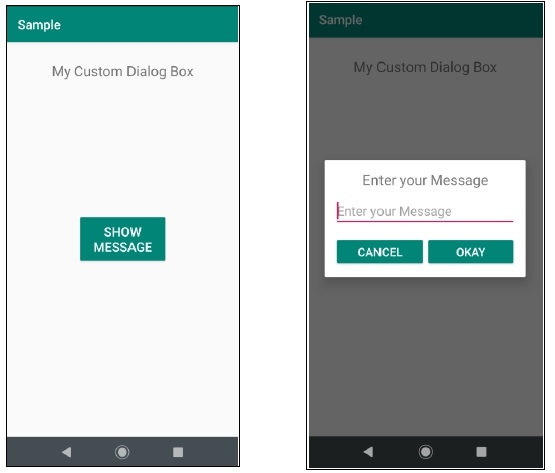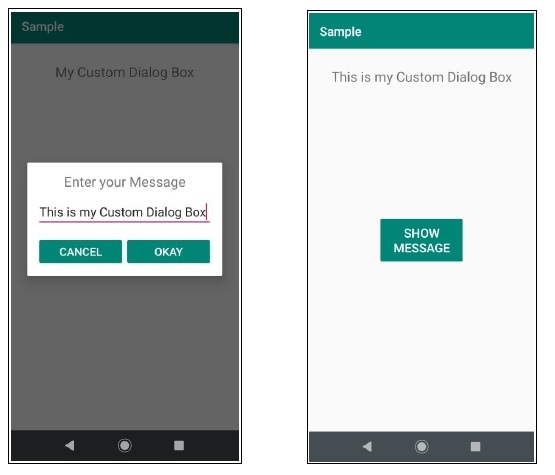
 Data Structure
Data Structure Networking
Networking RDBMS
RDBMS Operating System
Operating System Java
Java MS Excel
MS Excel iOS
iOS HTML
HTML CSS
CSS Android
Android Python
Python C Programming
C Programming C++
C++ C#
C# MongoDB
MongoDB MySQL
MySQL Javascript
Javascript PHP
PHP
- Selected Reading
- UPSC IAS Exams Notes
- Developer's Best Practices
- Questions and Answers
- Effective Resume Writing
- HR Interview Questions
- Computer Glossary
- Who is Who
How to create a Custom Dialog box on Android?
This example demonstrates about how do I create a custom message in Android.
Step 1 − Create a new project in Android Studio, go to File ⇒ New Project and fill all required details to create a new project
Step 2 − Add the following code to res/layout/activity_main.xml.
<?xml version="1.0" encoding="utf-8"?> <RelativeLayout xmlns:android="http://schemas.android.com/apk/res/android" xmlns:tools="http://schemas.android.com/tools" android:layout_width="match_parent" android:layout_height="match_parent" tools:context=".MainActivity"> <TextView android:layout_width="match_parent" android:layout_height="wrap_content" android:text="My Custom Message" android:textSize="22sp" android:textAlignment="center" android:layout_marginTop="30dp" android:id="@+id/myCustommessage"/> <Button android:layout_width="140dp" android:layout_height="80dp" android:layout_centerInParent="true" android:text="Show Message" android:backgroundTint="@color/colorPrimary" android:textSize="20dp" android:textColor="#ffffff" android:onClick="btn_showMessage" /> </RelativeLayout>
Step 3 − Click res from Project → Right click on layout → Select New → Layout resource file → Name the layout = “ custom_dialog, enter Linear layout in the “Root element” and click okay
Step 4 − Add the following code to custom_dialog.xml
<?xml version="1.0" encoding="utf-8"?> <LinearLayout xmlns:android="http://schemas.android.com/apk/res/android" android:orientation="vertical" android:layout_width="match_parent" android:layout_height="match_parent" android:padding="15dp"> <TextView android:layout_width="match_parent" android:layout_height="wrap_content" android:text="Enter your Message" android:textSize="22sp" android:textAlignment="center" /> <EditText android:id="@+id/txt_input" android:layout_width="match_parent" android:layout_height="wrap_content" android:layout_marginTop="10dp" android:hint="Enter your Message" android:textSize="20sp" /> <LinearLayout android:layout_width="match_parent" android:layout_height="wrap_content" android:layout_marginTop="15dp"> <Button android:layout_width="match_parent" android:layout_height="wrap_content" android:backgroundTint="@color/colorPrimary" android:text="Cancel" android:textColor="#ffffff" android:textSize="18sp" android:layout_weight="1" android:id="@+id/btn_cancel"/> <Button android:layout_width="match_parent" android:layout_height="wrap_content" android:backgroundTint="@color/colorPrimary" android:text="Okay" android:textColor="#ffffff" android:textSize="18sp" android:layout_weight="1" android:id="@+id/btn_okay"/> </LinearLayout> </LinearLayout>
Step 5 − Add the following code to src/MainActivity.java
import android.support.v7.app.AlertDialog;
import android.support.v7.app.AppCompatActivity;
import android.os.Bundle;
import android.view.View;
import android.widget.Button;
import android.widget.EditText;
import android.widget.TextView;
public class MainActivity extends AppCompatActivity {
TextView myCustomMessage;
@Override
protected void onCreate(Bundle savedInstanceState) {
super.onCreate(savedInstanceState);
setContentView(R.layout.activity_main);
myCustomMessage = (TextView)findViewById(R.id.myCustommessage);
}
public void btn_showMessage(View view){
final AlertDialog.Builder alert = new AlertDialog.Builder(MainActivity.this);
View mView = getLayoutInflater().inflate(R.layout.custom_dialog,null);
final EditText txt_inputText = (EditText)mView.findViewById(R.id.txt_input);
Button btn_cancel = (Button)mView.findViewById(R.id.btn_cancel);
Button btn_okay = (Button)mView.findViewById(R.id.btn_okay);
alert.setView(mView);
final AlertDialog alertDialog = alert.create();
alertDialog.setCanceledOnTouchOutside(false);
btn_cancel.setOnClickListener(new View.OnClickListener() {
@Override
public void onClick(View v) {
alertDialog.dismiss();
}
});
btn_okay.setOnClickListener(new View.OnClickListener() {
@Override
public void onClick(View v) {
myCustomMessage.setText(txt_inputText.getText().toString());
alertDialog.dismiss();
}
});
alertDialog.show();
}
}
Step 6 − Add the following code to androidManifest.xml
<?xml version="1.0" encoding="utf-8"?> <manifest xmlns:android="http://schemas.android.com/apk/res/android" package="app.com.sample"> <application android:allowBackup="true" android:icon="@mipmap/ic_launcher" android:label="@string/app_name" android:roundIcon="@mipmap/ic_launcher_round" android:supportsRtl="true" android:theme="@style/AppTheme"> <activity android:name=".MainActivity"> <intent-filter> <action android:name="android.intent.action.MAIN" /> <category android:name="android.intent.category.LAUNCHER" /> </intent-filter> </activity> </application> </manifest>
Let's try to run your application. I assume you have connected your actual Android Mobile device with your computer. To run the app from android studio, open one of your project's activity files and click Run ![]() icon from the toolbar. Select your mobile device as an option and then check your mobile device which will display your default screen −
icon from the toolbar. Select your mobile device as an option and then check your mobile device which will display your default screen −


Click here to download the project code.

